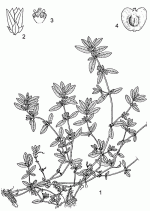
Record display
 PROTA4U Homepage
PROTA4U Homepage Select translation pop-up: Select translation pop-up: |
 |
PROTA4U Record display |
 PROTA4U Homepage PROTA4U Homepage
|
| Cat. pl. horti monsp.: 77 (1813). | |||
| show more data (13) | comments (0) |
| Amaranthaceae | |||
| show more data (12) | comments (0) |
| 2n = 34, 96 | |||
| show more data (4) | comments (0) |
| show more data (38) | comments (0) |
| Sessile joyweed, dwarf copperleaf (En). Brède chevrette, magloire (Fr). Periquito-sessil (Po). | |||
| show more data (10) | comments (0) |
| Alternanthera sessilis possibly originates from tropical America but is now widespread in the tropics and subtropics of the world, including the whole of tropical Africa. | |||
| show more data (39) | comments (0) |
| In many places of the world, the leaves of Alternanthera sessilis are eaten as a cooked vegetable or raw as a salad. In tropical Africa its use as a vegetable has been reported from Guinea (where it is used in place of rice as a staple and is said to be satiating), Benin (in sauces and soup), Nigeria (in soup), DR Congo, Tanzania and Zambia (as a relish), as well as from Madagascar and Réunion (as a potherb). In Sri Lanka the plant is tied in bundles and sold on markets for use in salads. It is also exported to Europe for clients of South-Indian origin. Alternanthera sessilis is used for simple stomach disorders, diarrhoea, dysentery and as a plaster for diseased or wounded skin parts and against fever. In Ghana a decoction with some salt is taken to stop vomiting blood. In Nigeria the pounded plant is used against headache and vertigo, and leaf sap is sniffed up the nose to treat neuralgia. A paste is used to draw out spines or any other object from the body and it is also used to cure hernia. In Senegal and India leafy twigs, ground to a powder, are applied against snakebites. The plant is also used in veterinary medicine in Kenya. Alternanthera sessilis is used in local medicine in Taiwan, often in mixtures with other medicinal plants, to treat hepatitis, tight chest, bronchitis, asthma and other lung troubles, to stop bleeding and as a hair tonic. In India it is used as a cholagogue, abortifacient and febrifuge, in Thailand and Sri Lanka as a galactagogue. | |||
| show more data (23) | comments (0) |
| show more data (1) | comments (0) |
| The fresh leaves of Alternanthera sessilis contain per 100 g: water 80 g, energy 251 kJ (60 kcal), protein 4.7 g, fat 0.8 g, carbohydrate 11.8 g, fibre 2.1 g, Ca 146 mg, P 45 mg (Leung, W.-T.W., Busson, F. & Jardin, C., 1968). In Alternanthera sessilis the following compounds have been demonstrated to be present: the triterpenes α-spinasterol, β-spinasterol, stigmasterol, β-sitosterol, oleanotic acid and its derivatives and saturated (aliphatic) esters. The leaves contain dietary fibre (about 12 g per 100 g dry matter) and incorporation of about 75 g of this vegetable fibre in the daily diet of diabetics significantly reduced the postprandial blood glucose level. In tests in India, leaf pastes of Alternanthera sessilis exhibited inhibition of mutagenicity in Salmonella typhimurium strains. They inhibited the formation of the potent environmental carcinogen nitrosodiethanolamine from its precursors such as triethanolamine. The aqueous alcohol extract of the entire plant exhibits hypothermic and histaminergic activities and relaxes smooth muscles. An ether extract of Alternanthera sessilis yielded an active principle having anti-ulcerative properties. | |||
| show more data (1) | comments (0) |
| Perennial, sometimes annual herb up to 1 m tall, erect, ascending or creeping, often widely branched, with robust taproot; stem striate, terete below, slightly tetragonous above, solid, sometimes floating in water and fistulose in lower part, stem and branches with narrow lines of whitish hairs and branch and leaf axils with tufts of white hairs. Leaves opposite, simple; petiole up to 5 mm long; blade linear-lanceolate, oblong to ovate or obovate, 1–15 cm × 0.2–3 cm, glabrous to sparsely pilose. Inflorescence an axillary, sessile, subglobose head 5 mm in diameter, solitary or in clusters of up to 5. Flowers bisexual, regular, 5-merous; tepals free, equal, ovate to elliptical, up to 2.5 mm long, white to pinkish, 1-veined; stamens united at base into a very short cup, 2 without anthers; ovary superior, strongly compressed, 1-celled, style very short. Fruit an obreniform, corky, indehiscent capsule c. 2 mm long, dark brown, 1-seeded. Seed discoid, c. 1 mm long, shiny brown. Alternanthera comprises about 200 species, distributed pantropically but most abundantly in tropical America. In tropical Africa about 6 species are found. Alternanthera nodiflora R.Br. (synonym: Alternanthera sessilis (L.) DC. var. nodiflora (R.Br.) Kuntze), closely related to Alternanthera sessilis, originates from Australia, but is also widespread in Africa. Its tepals are 3–4 mm long and its fruits are pale brown to yellow. Its ecological requirements are similar to those of Alternanthera sessilis. It is eaten in Tanzania as a vegetable and as a famine food in Nigeria. It is grazed by all stock. Medicinally, it has more or less the same uses as Alternanthera sessilis. It showed molluscicidal properties against the freshwater snails Bulinus and Biomphalaria. Alternanthera sessilis flowers and fruits throughout the year with most vigorous vegetative growth at the onset of the rainy season and the most vigorous reproductive growth at the end of it. The flowers are self-pollinated and the fruits are dispersed by wind and water. | |||
| show more data (0) | comments (0) |
| show more data (15) | comments (0) |
| show more data (1) | comments (0) |
| Alternanthera sessilis is a very common plant of constant or periodically humid, open localities in roadsides, gardens, ditches, swamps, ricefields and tea plantations, on many types of soil, at up to 1800 m altitude. The dark, corky fruits often float in great quantities on the water. In fields (e.g. rice) and along watercourses, Alternanthera sessilis can become a noxious aquatic or terrestrial weed. It prefers loamy, alkaline soil, low in exchangeable calcium and rich in total nitrogen. | |||
| show more data (9) | comments (0) |
| show more data (2) | comments (0) |
| Alternanthera sessilis is collected from the wild and not cultivated. It can easily be propagated by seed and by rooted stem parts. The average number of seeds per plant is about 2000. A leaf-spot disease caused by Fusarium pallidoroseum has been described in Nigeria. It may spread to crops in which Alternanthera sessilis occurs as a weed, e.g. okra, yams, potatoes, onions and carrots. | |||
| show more data (0) | comments (0) |
| Alternanthera sessilis is widespread and not in danger of genetic erosion. | |||
| show more data (0) | comments (0) |
| Alternanthera sessilis will remain a vegetable of minor importance. The medicinal properties of this common, always available species, deserve more scientific attention, although in many locations it is considered a noxious weed and focus is on its eradication. | |||
| show more data (0) | comments (0) |
| • Burkill, H.M., 1985. The useful plants of West Tropical Africa. 2nd Edition. Volume 1, Families A–D. Royal Botanic Gardens, Kew, Richmond, United Kingdom. 960 pp. • Lemmens, R.H.M.J. & Horsten, S.F.A.J., 1999. Alternanthera Forssk. In: de Padua, L.S., Bunyapraphatsara, N. & Lemmens, R.H.M.J. (Editors). Plant Resources of South-East Asia No 12(1). Medicinal and poisonous plants 1. Backhuys Publishers, Leiden, Netherlands. pp. 105–109. • Leung, W.-T.W., Busson, F. & Jardin, C., 1968. Food composition table for use in Africa. FAO, Rome, Italy. 306 pp. • Townsend, C.C., 1985. Amaranthaceae. In: Polhill, R.M. (Editor). Flora of Tropical East Africa. A.A. Balkema, Rotterdam, Netherlands. 136 pp. • van der Zon, A.P.M. & Grubben, G.J.H., 1976. Les légumes-feuilles spontanés et cultivés du Sud-Dahomey. Communication 65. Département des Recherches Agronomiques, Koninklijk Instituut voor de Tropen, Amsterdam, Netherlands. 111 pp. | |||
| show more data (46) | comments (0) |
| • Aruna Krishnakumar, Sivaramakrishnan, V.M., Sivaswamy, S.N., & Krishnakumar, A., 1991. Inhibition of nitrosation reaction by some spices/leafy vegetables. Advances in Plant Sciences 4(1): 189–193. • Burkill, H.M., 2000. The useful plants of West Tropical Africa. 2nd Edition. Volume 5, Families S–Z, Addenda. Royal Botanic Gardens, Kew, Richmond, United Kingdom. 686 pp. • Datta, S.C. & Biswas, K.K., 1979. Autecological studies on weeds of West Bengal 8. Alternanthera sessilis (L.) DC. Bulletin of the Botanical Society of Bengal 33: 1–2, 5–26. • Kerharo, J. & Adam, J.G., 1974. La pharmacopée sénégalaise traditionnelle. Plantes médicinales et toxiques. Vigot & Frères, Paris, France. 1011 pp. • Sreedevi & Chaturvedi, A., 1993. Effect of vegetable fibre on post prandial glycemia. Plant Foods for Human Nutrition 44(1): 71–78. • Townsend, C.C., 1988. Amaranthaceae. In: Launert, E. (Editor). Flora Zambesiaca. Volume 9, part 1. Flora Zambesiaca Managing Committee, London, United Kingdom. pp. 28–133. • Watt, J.M. & Breyer-Brandwijk, M.G., 1962. The medicinal and poisonous plants of southern and eastern Africa. 2nd Edition. E. and S. Livingstone, London, United Kingdom. 1457 pp. | |||
| show more data (26) | comments (0) |
| show more data (3) | comments (0) |
| • Lemmens, R.H.M.J. & Horsten, S.F.A.J., 1999. Alternanthera Forssk. In: de Padua, L.S., Bunyapraphatsara, N. & Lemmens, R.H.M.J. (Editors). Plant Resources of South-East Asia No 12(1). Medicinal and poisonous plants 1. Backhuys Publishers, Leiden, Netherlands. pp. 105–109. | |||
| show more data (2) | comments (0) |
| |||||
| |||||||
| |||||||
| |||||||
| Jansen, P.C.M., 2004. Alternanthera sessilis (L.) DC. [Internet] Record from PROTA4U. Grubben, G.J.H. & Denton, O.A. (Editors). PROTA (Plant Resources of Tropical Africa / Ressources végétales de l’Afrique tropicale), Wageningen, Netherlands. <http://www.prota4u.org/search.asp>. Accessed . | |||
| There are 12 study abstracts related to Alternanthera sessilis (L.) DC.. Click on "show more" to view them. | ||
| show more data | comments (0) |
| There are 100 book citations related to Alternanthera sessilis (L.) DC.. Click on "show more" to view them. | ||
| show more data | comments (0) |
| There are 101 citation in web searches related to Alternanthera sessilis (L.) DC.. Click on "show more" to view them. | ||
| show more data | comments (0) |
| There are 87 citation in scholarly articles related to Alternanthera sessilis (L.) DC.. Click on "show more" to view them. | ||
| show more data | comments (0) |
| There are 14 news article citations related to Alternanthera sessilis (L.) DC.. Click on "show more" to view them. | ||
| show more data | comments (0) |
| There are 20 citations in Afrirefs related to Alternanthera sessilis (L.) DC.. Click on "show more" to view them. | ||
| show more data | comments (0) |
| There are 11 Wikipedia citations related to Alternanthera sessilis (L.) DC.. Click on "show more" to view them. | ||
| show more data | comments (0) |
| General importance |  |
| Geographic coverage Africa |  |
| Geographic coverage World |  |
| Vegetables |  |
| Ornamental use |  |
| Medicinal use |  |
| Food security |  |

